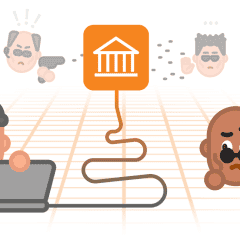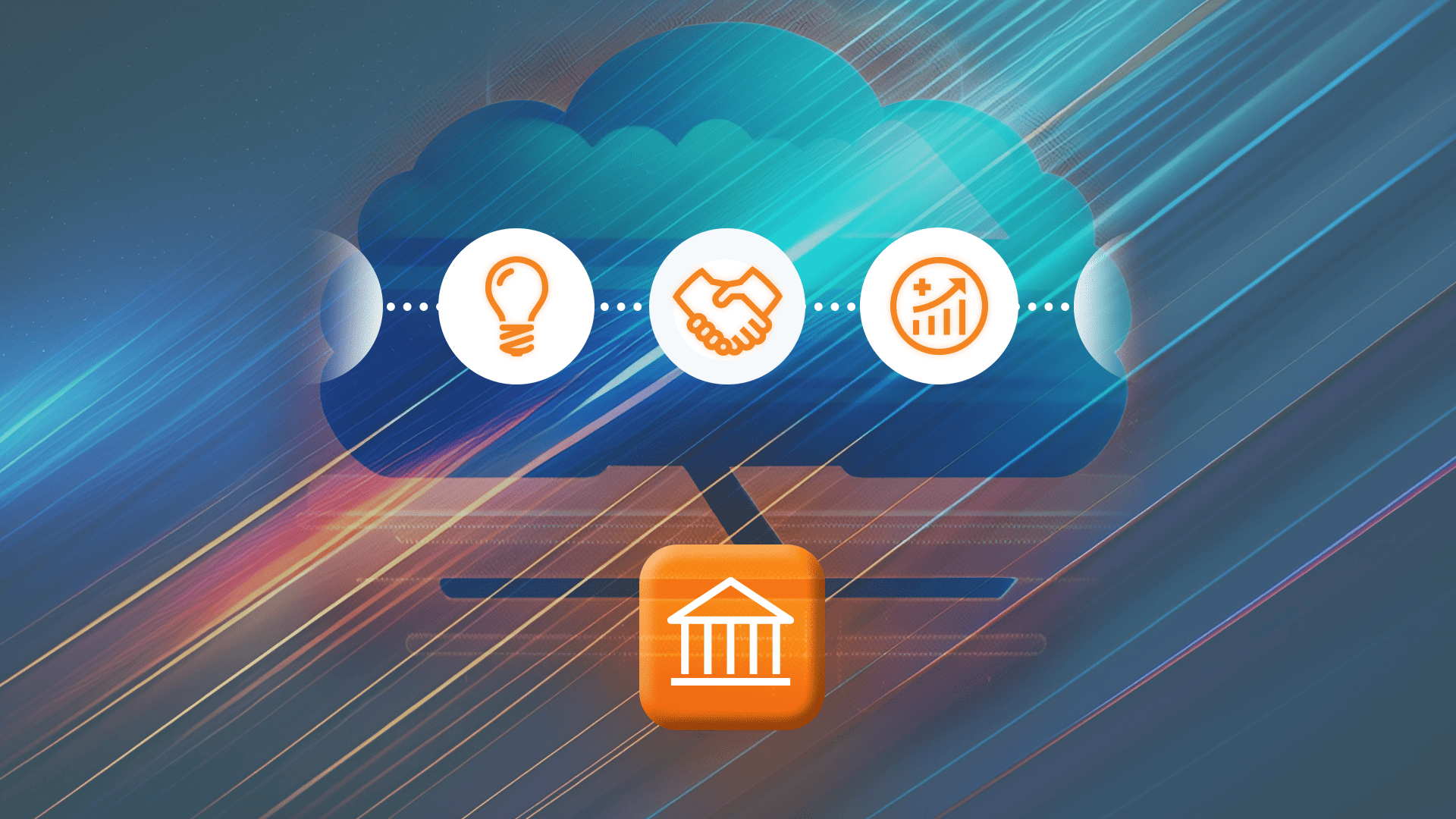If you’re a provider of telephony services to businesses – a.k.a. hosted PBX services or UCaaS (unified communications as a service) – you probably know that the (reasonably) good old traditional methods of selling telecommunication services are no longer enough. Businesses today want more than a big blocky desk phone with basic call functionality. They want a holistic approach that seamlessly integrates their cloud PBX service into the rest of their workflows. Think in particular: the all-powerful CRM system. They want every detail about every customer all in one place, to help businesses turn transactions into relationships.
The increasing integration of PBX services into other business systems is a significant shift. But it’s only getting started. While every change comes hand-in-hand with challenge, this particular shift is only good news to service providers that are willing to expand their vision. So, to help you see a bit further into the cloud PBX future, today we are delivering a truckload of inspiration for turning isolated business telephony services into comprehensive, vertically integrated business solution packages.
Are you ready to boost your customers’ operational efficiency while unlocking new revenue streams for your own business? Read on.
Hosted PBX vs Cloud PBX: Same, but Different?
What is hosted PBX or cloud PBX? On a simplistic level, hosted PBX and cloud PBX mean the same thing. Both are a virtual PBX (private branch exchange) business telephony system that is hosted by the service provider rather than by the businesses themselves. But the term cloud PBX is gaining ground. Perhaps that’s because of the metaphor that lives in its name: big, blue-sky possibility.

Traditional PBX has been the backbone of business communication for a very long time. These systems facilitate internal and external calls to and within organizations through a network of phones and extensions. (Picture again those big blocky desk phones, perhaps this time with a bunch of red bleeping lights on it representing callers on hold.) In the old days, these systems were heavily reliant on physical hardware. That meant businesses had to make a substantial upfront investment and provide lots of dedicated space for equipment.
The advent of cloud computing revolutionized this model, ushering in the modern era of cloud PBX. Cloud PBX systems leverage the internet for call routing, eliminating the need for bulky hardware and enabling unparalleled scalability and flexibility. This shift not only helped companies and service providers streamline their infrastructure, it also dramatically reduced the costs of business telephony. This was groundbreaking for smaller businesses and startups in particular. Suddenly, they could afford an advanced phone system. No more single-line phone, no more busy signals.
But progress, as we know, never rests on its laurels. Indeed, cloud PBX has been game-changing. Now it’s time for the game to change again.
A Better Cloud PBX Service: Productivity, Not Product
Today’s market is full of companies offering voice services with attractive bundles and all the basic features. From the customer’s perspective, they are all selling basically the same product. That means the only way these companies can compete with each other is to keep on dropping their prices. In other words, the proverbial race to the bottom. Nobody wins a price war, so why join that battle? If you truly want to attract customers and maintain profitability, you have to do something no one else is doing, or speak to a market no one else is speaking to.
And when it comes to the business market, you can’t just offer a simple product. As the title says, you have to offer productivity. Solve a problem. Make their life easier. Make their profits higher.
We no longer live in a business world where calling, data usage, contact lists, customer records, customer service, sales, billing & charging, and accounting are considered distinct departments. Change is a constant. If you want to hold on to a business customer, you have to meet all of these needs. What’s more, you have to do it in a united way.
Advanced PBX to the Rescue
Luckily, many UCaaS platform providers are stepping up to that challenge. Modern cloud PBX is scalable and customizable. It can also be integrated with other platforms and solutions to create unique, tailored products that solve enterprise customers’ problems, cohesively:
- As a PBX service provider, you can help your business customers stay nimble, scaling their telephony services up or down quickly based on current needs and budgets.
- You can help companies support a remote workforce, with employees accessing a company’s phone system from anywhere.
- By integrating your cloud PBX offering with CRM systems, you enable personalized customer interactions, improving satisfaction and loyalty.
And, when it comes to PortaOne platforms, telcos can choose between an unlimited perpetual license or a SaaS (software as a service) model. Each offers the ability to scale as fast as you need to, without escalating per-subscriber costs.
So, with a flexible, customizable, and scalable platform behind you and a vision to create a new kind of service ahead of you, all you need now is a little inspiration. To that end, here are a few fresh ideas for a comprehensive cloud PBX service that will help your business customers grow.
Idea #1: Vertical Integration of Cloud PBX and CRM
Let’s go back for a moment to that point about CRM integration. Undeniably, this is where some serious customer-pleasing (and regular revenue generating) power lies.

The synergy between PBX and CRM can strengthen a business’s customer relationships by weaving comprehensive insights and analytics into each individual interaction – from a sales call to an SMS campaign. This kind of personalized communication experience is worth its (digital) weight in gold.
Take one of our UK-based customers, for example. CloudCall was a very early adopter of this idea. The UCaaS provider leveraged PortaSwitch integration to create a solution that seamlessly delivers information from calls and chats into their enterprise customers’ CRM systems. Now, sales teams at those businesses can tap into that information to offer a better user experience.
“There are three components of brilliant customer relationship management,” explained PortaOne CEO Andriy Zhylenko in an interview about the project with UC Today. Those three components are: “a single platform through which all of an enterprise’s communications flow; a feature-rich CRM platform which provides a single view of that activity; and the seamless integration of them both.”
Let’s Look at the Stats
The upshot? Now, instead of grinding away at trying to sell, say, 10 phone lines for $10 each, you can sell a complete productivity package. Based on confirmed results, this can enable a customer support team to:
- Handle 30% more calls (by automating outbound calling or popping up customer contact automatically on an inbound call – think: no time wasted on “What is your customer ID?”)
- Free up hour of sales agent and supervisor time every single (since they can now quickly review call transcripts or AI-generated summaries when checking on the status of a deal)
- Resolve customer complaints or train junior staff members more effectively (by referring back to call recordings to review the details of a customer call or help an agent learn from past calls)
- Send reminders or booking invitations to customers about demos, events, or appointments (thanks to advanced IVR – interactive voice response – technology)
- And much more…
Leveraging these benefits can generate thousands of dollars of extra revenue, for, say, an overall cost of $200 monthly. An exclamation point seems hardly enough to underscore this math! In short: it seems like an obvious choice. With these tailored integrations, you have turned your customer’s basic PBX system into a dynamic, adaptable communications hub. Now you have a higher average revenue per customer (ARPC), more revenue reliability, and more “stickiness.” All because you turned yourself into an integral service rather than a tradeable commodity.
In a word: 🙌
Idea #2: Cloud PBX as a Gateway to Selling Service Bundles
As traditional pricing models based on the number of lines or minutes used give way to a more comprehensive package approach, that is opening the door for truly customized bundled offerings. With so many low- and no-code value-added services (VAS) available to “plug in” to your foundational PBX service, you have the opportunity to tailor a suite of services for each customer for a fixed monthly fee.
Kalaam Telecom, a PortaOne customer based in Bahrain, broke into the Saudi Arabian market with a cloud PBX service that included Microsoft Teams and Zoom integrations, built-in softphone, and more. They can adjust their packages to suit the needs of each business customer, and, since cloud PBX is a relatively new service in that country, they offer free trial runs to prove exactly how useful it can be for driving productivity. (The fact that PortaSwitch can easily be adapted to suit unique – and strict – local legislation is just an added bonus.)
Idea #3: Use Cloud PBX to Catalyze Startup and SME Growth
Let’s take a moment now to celebrate the little guys. Yes, selling a regular monthly business productivity package is undeniably good. What’s even better? Having that business scale the services they need from you as they grow. That’s why startups and SMEs are a valuable customer base for any service provider selling integrated PBX.
How does cloud PBX help to grow startups? For entrepreneurs and SMEs, agility and efficient resource management are crucial for survival and growth. Your robust, integrated, and tailored cloud PBX service can equip these burgeoning companies with sophisticated communication tools that are both cost-effective and scalable. This adaptability is vital, allowing startups to align their telephony needs with their growth trajectory and operational demands.
If you want to build a full-featured PBX ecosystem that can help SMEs and startups thrive – and to convince them to step on board – take some cues from these use-case ideas:
Increase Their Cost Efficiency
- Lower their initial and operational costs: Cloud PBX can operate on a subscription model, significantly reducing initial and operational expenses. No need for any substantial upfront investments in hardware or ongoing costs in maintenance and upgrades.
- Offer scalability: You can set startup companies up to easily scale their phone system as they grow, paying only for what they use. Consequently, they can add or remove lines and features according to their needs without investing in new hardware.
Provide Flexibility and Mobility
- Enable a remote workforce: Take that cue from Kalaam Telecom and equip SMEs to meet the needs of a remote workforce. This is a critical feature in today’s work environment. Help them use Zoom and Teams integration to make remote meetings simple.
- Or why not go for full fixed mobile convergence? Now go a step further than enabling remote work! Get inspired by UK-based PortaSwitch customer OnSIM and enable your business customers to have a completely mobile workforce. Today, it’s possible to provide a PBX offering that’s designed to offer the total experience of an in-office desk phone system, but delivered entirely via smartphone. Even better? Employees can use the same device for their personal and business use with seamless switching between their SIM and eSIM. Personal calls from their personal number remain completely their own. Meanwhile, business calls from their business number have the full office PBX features, including call recording.
- Offer affordable productivity: With the subscription model combined with low-code VAS offerings, you can provide your enterprise customers with business tools they might not otherwise be able to afford.
Enable Innovation and Growth Adaptability
- Offer the latest new features, fast: PortaSwitch has an agile 7-week update schedule, which means new features and capabilities are being rolled out regularly. Better, you can typically tap into these features for your cloud PBX customers without the need for specialized IT staff.
- Empower them with data insights: Some cloud PBX solutions offer analytics and reporting tools, providing startups with valuable insights into call patterns, customer service efficiency, and more. This data can be used to make informed decisions and to refine strategies for growth.
- Help launch their IoT innovations: The growth of IoT cannot be ignored. If they have IoT ideas, you can be the bridge that helps bring them to life.
Elevate Their Brand Image
- Help them improve their customer experience: Features such as auto-attendant, call routing, voicemail-to-email, and custom greetings help create a professional image for an SME, no matter its actual size. That means more credibility, and more customer loyalty.
- Offer reliability and quality: High-quality voice services and reliability improve customer interactions, contributing positively to the brand image. System redundancy and georedundancy further protect service continuity, especially in regions where there is a higher risk of outages.
Idea #4: Go Beyond Cloud PBX with an AI-Driven Business Telephony Service
The emergence of artificial intelligence 🤖 technologies is pushing the boundaries of what a cloud PBX service can achieve. By harnessing the power of AI-driven natural language processing and voice recognition, you can help businesses make their customer interactions more intuitive and effortless.
Additionally, predictive analytics and sentiment analysis can empower businesses with valuable insights into their customers’ needs and behaviors. By offering these tools, you can enable your enterprise customers to take a proactive and personalized approach to customer service. (Meaning: greater satisfaction, and greater loyalty.) A bonus AI benefit? It can actually help businesses strengthen their security measures and prevent fraud through advanced voice biometrics and anomaly detection.
The synergy of AI and cloud PBX isn’t just an upgrade, however. AI-powered business telephony transcends traditional call functionalities, offering a plethora of advanced features. (And one heck of a competitive edge for your PBX service.) Let’s consider just a few:
- Speech-to-text conversion: Businesses can automatically transcribe recorded calls, making it easier to review conversations, ensure regulatory compliance, and train staff.
- Generative AI for summaries and minutes: With AI integration into a telephony service, businesses can generate concise summaries of lengthy discussions. A great way to guarantee that no critical details are missed and that follow-up actions are managed efficiently.
- Call sentiment analysis: With call analysis, businesses can gain valuable insights into customer sentiment. It can also help identify competitor mentions, detect inappropriate language, and gauge the overall tone of conversations. This intelligence is becoming instrumental in refining customer service strategies, training customer service representatives, and gaining a deeper understanding of client needs.
Idea #5: Trade in Your Basic Cloud Call Center for a CX Solution
Modern cloud PBX is also redefining the customer service landscape. The traditional call center is being replaced with something that more closely resembles a comprehensive customer experience (CX) solution.
Today’s consumers crave flexibility. They also want the ability to interact with companies through their own preferred channels, whether that’s WhatsApp, Facebook, their mobile phone, or something else entirely. Cloud-based CX solutions address this need by seamlessly integrating these channels into a unified platform. Even better if it’s brimming with features designed to enhance customer satisfaction and loyalty.
Here are just a few of the features you could offer:
Omnichannel Helpdesk
This is the heart of a comprehensive CX platform. An omnichannel helpdesk can empower customers to connect effortlessly through their preferred method. This fosters a smooth experience that builds trust and loyalty. You can take the personalization further through CRM integration. Think: screen pops displaying customer information during calls, streamlined contact creation from calls, call disposition tagging, in-depth reporting… By offering these tools, you can help businesses ensure that every customer interaction is efficient and tailored to the individual.
AI-Boosted Customer Relationships
Cloud PBX-based CX solutions leverage the power of AI to enhance understanding for both customers and call center agents. Real-time transcriptions and captions generated by AI during calls can be used for compliance and training purposes. AI-prompted agent responses, meanwhile, can leverage a company’s knowledge base to suggest the most appropriate solutions to customer inquiries. (For the time being, of course, this should perhaps be paired with some experienced human oversight until either AI or the law irons out the kinks.) The overall upsides: faster resolution times and higher customer engagement.
Smart Auto-Dialers
Smart – a.k.a. predictive – auto-dialers can absolutely rocket-power productivity. In fact, bringing this tool into their call center product suite was a big part in helping our customer MMDSmart reach 1500% in annual growth! These intelligent systems calculate the optimal times to reach clients, significantly increasing connection rates and maximizing the efficiency of sales teams. This means you can help your cloud call center clients create a future where their customer interactions are seamless, personalized, efficient – and even scheduled at the most convenient time. (Yes: a future with fewer dinner interruptions!)
Supported by Trends and Predictions
These PBX advancements are not speculative; rather, they are grounded in observable trends and market predictions. The global shift toward remote work, heightened expectations for customer service, and the proliferation of AI and cloud technologies are all driving demand for more sophisticated communication solutions. According to industry analysts, the market for AI in telecommunication is expected to grow exponentially in the coming years, reflecting the critical role AI is playing in transforming this sector.

Businesses that have access to these advanced telecommunication solutions stand to gain a competitive edge: superior customer experiences, data-driven decisions, improved operational efficiency, and a more connected and flexible work environment. If you can enable that access, you will be gaining your own edge against your own competitors.
The Future of Business Communication: Powered by Integration and Innovation
The business world is witnessing a significant shift in how it communicates. The convergence of cloud PBX services, CRM systems, and artificial intelligence is ushering in a new era of unparalleled efficiency.
Your enterprise customers are no longer satisfied with siloed communication tools. Instead, they’re seeking solutions that effortlessly blend into their daily operations. To meet that demand, you have to evolve too. Gone are the days when you can just offer a simple communication tool and expect to compete. To thrive as a PBX provider, you need to position yourself as a strategic partner, helping your customers drive innovation.
The future demands communication solutions that extend beyond basic voice calls. They need to become deeply embedded within a company’s digital ecosystem, fostering stronger internal productivity, improved efficiency, and enhanced connectivity.
PortaOne clients have a long history of success in seamlessly integrating telephony with other business systems, and with advanced VAS. This approach not only strengthens the value proposition of their cloud PBX services, it also unlocks exciting possibilities for innovation, customer engagement, and operational streamlining.
Ready to try some of these innovations on your enterprise customer base? Discover how PortaOne can help your company into the future with scalable, integrated cloud PBX solutions. Reach out to us today to take the first step toward a smarter, more connected business landscape.
Cloud PBX service FAQs
Cloud PBX pricing depends on the provider, your country and location, the features you use, the number of employees, how many calls you make, and – potentially – several other factors. The costs will vary, but a typical range might be between $5 and $50 per active seat per month. Some providers might have extra charges for setup, special features, or calls to domestic or international destinations. Note: PortaOne does not directly provide cloud PBX services, does not influence cloud PBX pricing, and the pricing for our software platforms does not directly depend on these mentioned factors.
PBX stands for Private Branch Exchange. It’s a private phone system for businesses that lets people call each other and outside lines using different technologies like internet calls (VoIP), ISDN, or regular phone lines.
A cloud PBX system is like a regular PBX, but it’s hosted online instead of needing its own equipment on-site. This means a company can use its phone system over the internet. Cloud PBX is flexible, grows easily with any business, and can be enhanced with features like voicemail, call forwarding, auto-attendants, and more.
A cloud PBX provider is a company that sells PBX services over the internet. They take care of the data centers and software, so businesses don’t have to manage their own phone system equipment. Providers often offer a range of plans and features tailored to different business needs.
Cloud PBX 2.0 is the next generation of cloud PBX systems. It has more features, can connect with other business tools more easily, and is more reliable. This could include things like better connections with other software a business uses (CRM systems, for instance), artificial intelligence to help route calls, stronger security, and easy-to-use interfaces for managing and growing a business telephony system.











